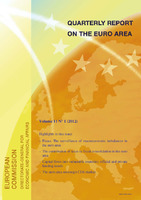| dc.contributor.author | European Commission |
| dc.date.accessioned | 2020-03-27T15:11:25Z |
| dc.date.available | 2020-03-27T15:11:25Z |
| dc.date.issued | 2012-01-10 |
| dc.identifier.issn | 1830-6403 |
| dc.identifier.uri | https://ketlib.lib.unipi.gr/xmlui/handle/ket/1447 |
| dc.description | Highlights in this issue: –Focus: The surveillance of macroeconomic imbalances in the euro area –The contribution of taxes to fiscal consolidation in the euro area –Capital flows into vulnerable countries: official and private funding trends –The euro-area sovereign CDS market |
| dc.description | Volume 11 No. 1 |
| dc.description | http://aei.pitt.edu/id/eprint/94720 |
| dc.description.abstract | The beginning of this year has seen further advances in stemming the tide of the euro-area crisis and setting right the remaining weaknesses in the economic governance framework. To be sure, during the course of last year the euro area was already put on a more stable institutional footing. A far-reaching drive at the European level has ensured that the vulnerabilities and blind spots that first gave rise to the crisis are being corrected. |
| dc.format.extent | 42p. |
| dc.language.iso | en |
| dc.publisher | European Commission |
| dc.subject | Economic and Financial Affairs |
| dc.title | European Economy. Quarterly report on the euro area 2012. |
| dc.type | working document |
| dc.publisher.place | Brussels |

